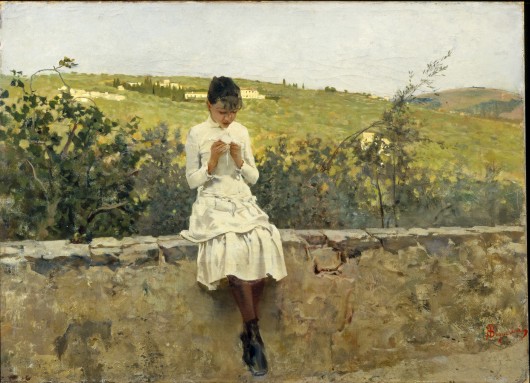Amy Always Kept Fresh Gladiolas on the Table
24" x 24" x 1.5 Acrylic and Mixed Media on Canvas
A Season's Awakening
16" x 16" x 1.5" Acrylic and Mixed Media on Canvas
Name: Gina Marie Dunn
Current City: Dallas
Hometown: Brooklyn, NY
Preferred Medium: Acrylic and Mixed Media on Canvas
Education: Loyola University in New Orleans- BA in Communications, Minor in Studio Arts
Tell me about you work in one sentence: With subject matter varying from cellular abstractions to modern landscapes, there is a dreamlike, organic aspect to my work that pervades.
Would you prefer to deal through gallery representation or directly with clients, why? I think there are good points to both. Art Galleries provide wonderful exposure of your work to a new audience. For example, my art gallery got my Valentine’s series of paintings featured in Daily Candy Dallas, something I probably could not have accomplished solo. Gallery representation also lends so much credibility to your work. However, having majored in Public Relations in college, I am no stranger to self-promotion and feel very comfortable pursuing independent opportunities to display my paintings as well as cultivating relationships with buyers.
What is your favorite forum/method of sharing information about art? I started a blog a few months ago and really enjoy updating it. I would have to say, though, that my Facebook group, Utopia Pkwy. Art Studio, has been a great venue to share information about new works and upcoming shows. You can reach people immediately and it is where I make the majority of my sales.
Your work is selected to show in a gallery or museum in the world, where would you choose? I would choose the San Francisco Museum of Modern Art so I would have an excuse to go back and visit my favorite city in the United States. The prestige of that Museum, to me, is unparalleled.
In what period of your career did you feel most aware of the needs of your audience, if ever? I feel that the past year, when I have been most prolific in my painting, has allowed me to get more in tune with the needs of my audience. Only by producing works and receiving feedback, as well as building strong relationships with my Buyers has really helped me understand what I should focus my efforts on.
The art world right now is experiencing a newfound medium of exchanging information virtually. Do you think that this has affected the relevance of galleries, studios, and museums? No, I feel it has simply opened another portal in which information can be exchanged and only serves to enhance the relevance of galleries, studios and museums.
Would you rather have your work well known in the art community or well understood in the general population? Right now I am working on getting a strong local following…after that I will start taking on a wider audience.
Who are your artistic influences? Marc Chagall, Charles Burchfield, Henri Matisse, Frida Kahlo, Vincent Van Gogh
What is it about your work that makes it different from these people and relevant in today’s society? My work is highly personal because my creative process involves a lot of writing….either direct writing on my canvases or my collage-ing journal entries to form multi-layered texture pieces that have a lot of depth, both literally and figuratively. Often I feel like my paintings are my diaries screaming out loud, articulating with color, shape and texture what I can’t seem to put into words. This is relevant because I feel they speak to my audience on a direct level.
A major theme in your work seems to be dreams and their connection to the world beyond ourselves, is your interest in this at all related to the constant flood of “reality” that we are subject to due to the power of the media whether relating to the news, celebrity events, or reality television? I believe that on a subconscious lever, my paintings are an escape from the constant flood of "reality" that we are all subject to, they are a retreat into my own head, my own dreams, my own way of processing reality. I choose to paint and express my emotions creatively rather than be spoon-fed by other forces more powerful than I can control that tell me how I "should" feel.
Its 2012 and as the Mayans predicted, the world ends. Every cultural link is destroyed, but luckily there are few survivors. You are among them and are selected to document our cultural past. What artifact/artwork would you choose to record first? I would document Van Gogh’s The Starry Night (1889). It is one of the most famous and recognized paintings in the world for a reason…there is something about it that humans can relate to, identify with and be soothed by almost instantly. “I know nothing with any certainty, but the sight of stars makes me dream,” Van Gogh once said. That painting reminds humanity that we are at the mercy of powers greater than us and that life is precious and beautiful.
Check out other posts about Gina Marie Dunn at Daily Candy:












